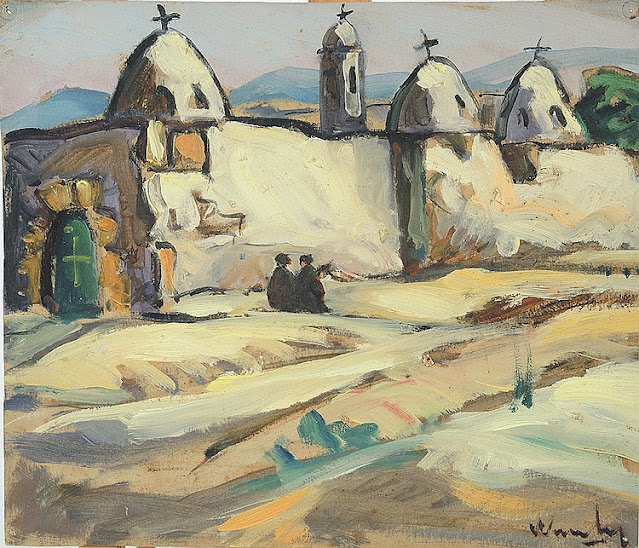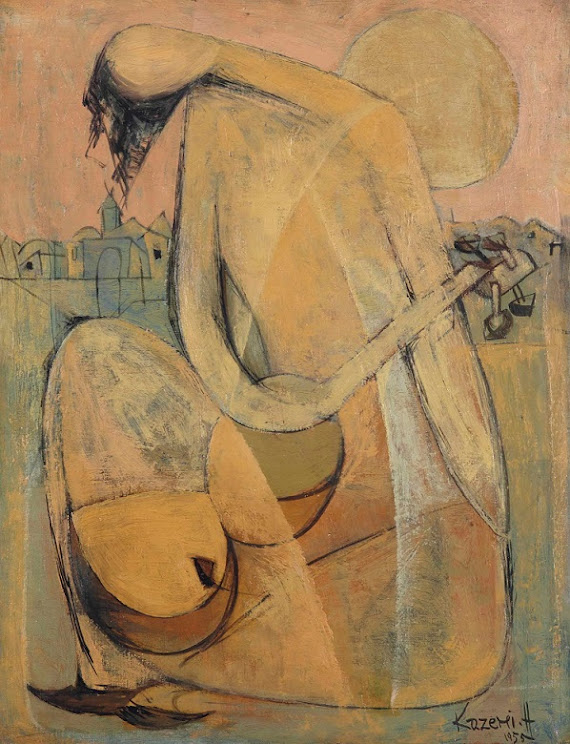Ibrahim El Dessouki, Egyptian, b. 1969
Doors and False Doors 5, c. 2021
Oil on canvas
72 4/5 × 47 1/5 in, 185 × 120 cm
Private collection
“False doors”, also known as “Ka doors”, as they allowed the Ka (an element of the “soul”) to pass through them, were common in the mortuary temples and tombs of ancient Egypt from around the Third Dynasty and temples of the New Kingdom. The false door was thought to be a threshold between the world of mortals and the world of deities and spirits. The deity or the deceased could interact with the world of the living either by passing through the door or receiving offerings though it. As a result it was not uncommon to find false doors depicted on the sides of coffins as well as on the cabinets of “shawabti”.
From the middle of the Fifth Dynasty, the decorations often included torus moulding (convex moulding resembling a semicircle in cross section) and a “cavetto cornice” (a concave bracket around the top of a wall or gate with a cross section that resembles a quarter circle in cross section). It is thought that these decorations represented the plants originally used to build predynastic buildings. Images of the deceased were also fairly common. Usually, the decoration was undertaken in such a manner that the deceased appeared to emerge from the false door itself. More on False doors
Ibrahim El Dessouki’s painting style is defined by his unique treatment of paint, accentuated by his ability to create subtle changes in its texture; his unusual use of negative space; and his deft manipulation of shadow and light. While the artist’s genres encompass portraiture, landscape and still life, El Dessouki’s subject matter is very much Egypt-centric, and captures his own unique and hypnotic perspective of the soul and essence of Egypt. More on this painting
Ibrahim El Dessouki (b. 1969, Cairo, Egypt) lives and works in Cairo as a painter of a highly condensed style in portraiture as well as in still life painting and landscape. His unique elaborate and highly meticulous treatment of shades & his refined textures that echo his feelings through an extraordinary & notable use of paint kneaded carefully to result in simultaneously dreamy & epic tones of color. Not to mention his immense sized shapes of women who pose at times to inspire awe and bewilderment showing off in the meantime details and mutations of degrees-of dimness, shades and light, to evoke the sense of tenderness and delicacy out of so many thick layers of rich and varied tints of paint which make the painting so vital and poetic.
Dessouki paints animals, still nature, landscape & women all in a soft, incredible & divine contemporary style. He is famous for his paintings of women; some of those paintings express his nostalgia for the women who strolled in his neighborhood when he was a child with their ample bodies hardly covered with a graceful shawl. His paintings of women are simple yet rich with grace and softness; his style is as pleasing to the eye and elegant as his subject matters.
Dessouki participated in exhibitions in Egypt and abroad. In 2003, he was part of the Panorama of 20th Century Egyptian Art in the Bibliotheca Alexandrina in Alexandria. In 2006 & 2008, he was an invited artist to the 10th and 11th Cairo International Biennale. More on Ibrahim El Dessouki
Please visit my other blogs: Art Collector, Mythology, Marine Art, Portrait of a Lady, The Orientalist, Art of the Nude and The Canals of Venice, Middle East Artists, 365 Saints and 365 Days, also visit my Boards on Pinterest
Images are copyright of their respective owners, assignees or others.
Some Images may be subject to copyright
I don't own any of these images - credit is always given when due unless
it is unknown to me. if I post your images without your permission, please tell
me.
I do not sell art, art prints, framed posters or reproductions. Ads are
shown only to compensate the hosting expenses.
If you enjoyed this post, please share with friends and family.
Thank you for visiting my blog and also for liking its posts and pages.
Please note that the content of this post primarily consists of articles
available from Wikipedia or other free sources online.


.jpg)










.png.jpg)

